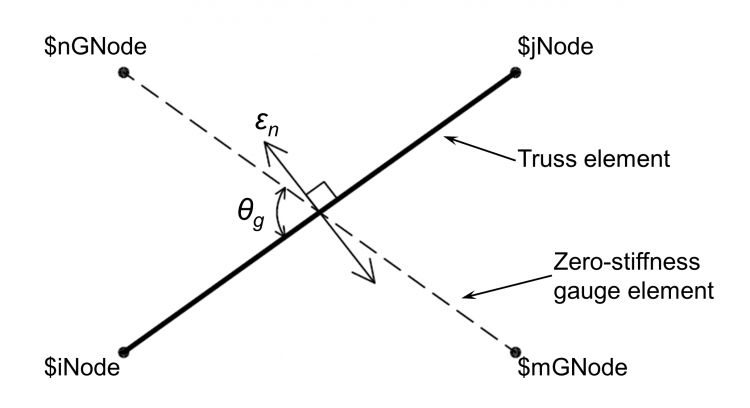Truss2 Element
This command is used to construct a Truss2 or CorotTruss2 element object, a biaxial truss element designed to be used in conjunction with the ConcretewBeta material for accounting for biaxial effects in a uniaxial element.
Truss:
| element Truss2 $eleTag $iNode $jNode $mGNode $nGNode $A $matTag <-rho $rho> <-rayleigh $rflag> |
Corotational Truss:
| element CorotTruss2 $eleTag $iNode $jNode $mGNode $nGNode $A $matTag <-rho $rho> |
| $eleTag | unique element object tag |
| $iNode $jNode | end nodes of the truss element |
| $mGNode $nGNode | end nodes for the zero-stiffness gauge element |
| $A | cross-sectional area of truss element |
| $matTag | tag of material used (see Note 1) |
| Optional: | |
| $rho | mass per unit length, as in the Truss and CorotTruss Elements (default = 0.0) |
| $rFlag | flag for Rayleigh damping, as in the Truss Element (default = 0; see Note 2) |
NOTES:
(1) If the material used does not use biaxial effects, the element will behave like the uniaxial counterpart (Truss or CorotTruss). For the ConcretewBeta material, the normal strain will be passed to the material to be used in calculation of the material response.
(2) Consistent with the implementation of the Truss element, the Truss2 element does not include Rayleigh damping by default. Rayleigh damping can be included by using the -rayleigh option with $rFlag = 1.
However, like the CorotTruss element, the CorotTruss2 element includes the Rayleigh damping by default so the -rayleigh option is not available to the CorotTruss2 element.
(3) At this time, there is no trussSection equivalent implementation of these biaxial trusses.
Implementation
The above figure shows the layout of the truss and zero-stiffness gauge elements that make up the Truss2 Element object. The truss element part behaves identically to the Truss Element object (or the CorotTruss Element object for the case of CorotTruss2).
The zero-stiffness gauge element is used to measure the strain in the direction of the gauge. The strain in the direction normal to the truss element is described by Equation 1, where εtruss is the strain calculated in the truss element, εgauge is the strain calculated in the gauge element, and θg is the angle between the truss and gauge elements. It is suggested to make θg as close to 90° as possible.
References
Lu, Y., and Panagiotou, M. (2013). “Three-Dimensional Nonlinear Cyclic Beam-Truss Model for Reinforced Concrete Non-Planar Walls.” Journal of Structural Engineering, published online.
Panagiotou, M., Restrepo, J.I., Schoettler, M., and Kim G. (2012). "Nonlinear cyclic truss model for reinforced concrete walls." ACI Structural Journal, 109(2), 205-214.
Code Developed by: Yuan Lu, UC Berkeley and Marios Panagiotou, UC Berkeley

